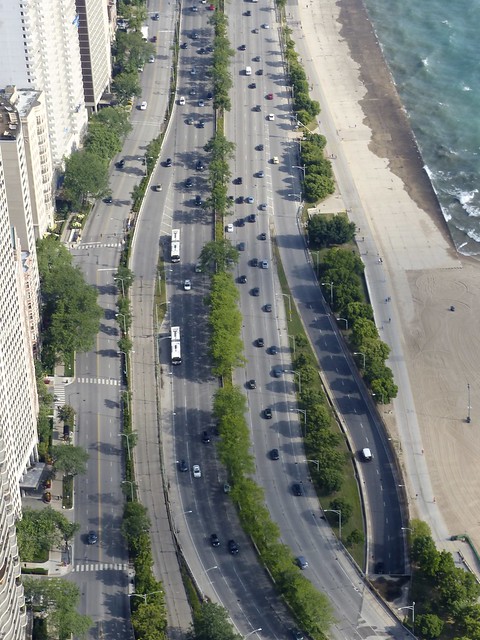
IDOT’s revisions to the newly updated North Lake Shore Drive “Purpose and Needs Statement,” an opening salvo that sets the tone for the long process of rebuilding the Drive, might not quite be on the same scale as landing on the moon. However, a few seemingly minor text edits signal a huge shift in how the agency will treat active transportation in the upcoming reconstruction. A comparison between the April draft statement [PDF] and the May draft [PDF] reveals substantial changes to what IDOT lists as the project's priorities.
The first major change is in the opening “Project Purpose” section. In the original document, “improve mobility for automobiles” was the first priority listed, with “buses and non-motorized modes of travel” lumped together afterwards. Looking over the new P&N, “improve safety” has moved to the top of the list, followed by “improve mobility for non-motorized modes of travel,” and then finally “buses and automobiles.” While this may look like a small difference, the statement illustrates the proper road user hierarchy — the safety of pedestrians and bicycles should come first, trailed by the need to move many buses and cars quickly. Similar changes have been made in other sections of the document.
In the original draft, the “Improve Safety for All Users” section had named vehicular safety first, with a small section afterwards about improving safety for “Non-Motorized Modes of Travel.” This time around, the two have been switched. Sadly, no new data or examples of major problem areas were added, whereas the vehicular section did see additional detail added.
Happily, the sub-sections under 1.4.2, “Improve Mobility for All Users,” have undergone a massive transformation. As with the other main sections in the first P&N, cars had led the list, with a meager three paragraphs about transit following, and a passable attempt to address “Lakefront Trail Mobility” last in line. This oversight has been rectified, with the Lakefront Trail section now leading. Under that is a significantly expanded section on “Transit Mobility,” with new information on issues that transit along the Drive faces. For instance, the document now recognizes that “in the 16 census tracts adjacent to study area, 35 percent of households own zero automobiles.”
IDOT also uses this section to address “Transit Service Quality,” referring to the frequent delays that CTA's "express" buses face during peak hours because of auto-induced traffic congestion. For instance, IDOT's new draft links the substantially lower ridership in the afternoon peak hour (33% lower than morning peak hour) to lower bus speeds caused by worse traffic congestion at that time. Furthermore, many bus stops along the Drive “do not meet ADA standards or lack sufficient capacity to accommodate peak demand operations.”
The rest of the changes primarily shift around sub-section content. For example, the “Address Infrastructure Deficiencies” sub-section now places “Roadway” below “Structures” and “ADA Requirements.” Another example, under “Improve Access and Circulation,” places “Non-Motorized Access to Lincoln Park” after “Vehicular Access to North Lake Shore Drive.”
These large and small changes show that IDOT is beginning to give the project the balance that it rightfully deserves. Provided that IDOT follows the outline that the Purpose and Needs has laid for the eventual alternatives analysis and environmental impact reports, its priorities will be in the right place -- on the north lakefront's pedestrians, bicyclists, and transit users. Going forward, ongoing public pressure will be needed to encourage IDOT to stick to these priorities.




